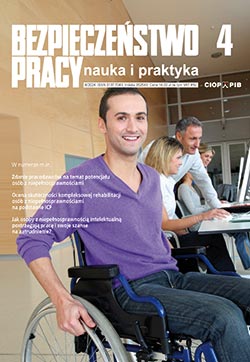Simulated cooperation with a robot in the virtual occupational environment. Survey research – theoretical foundation (1)
dr hab. inż. ANDRZEJ GRABOWSKI
The article presents the issue of the use of the virtual reality in order to study the impact of an industrial collaborative robot on an employee, in particular anxiety caused by the close presence of the robot. The research procedure is described, including simulation in virtual reality of cooperation with a robot during the assembly of engine components. The questionnaire tools planned to be used in research with volunteers and the results of the pilot research are described. The results of the final research will be described in the second part of the article.
The impact of the occupational exposure to organic solvents, metals and their compounds on reproduction
dr KATARZYNA MIRANOWICZ-DZIERŻAWSKA
The article presents an overview of literature-based data which paint the picture of the results of occupational exposure to selected metals and organic solvents. Both presented in the article lead, mercury and cadmium, and the mentioned solvents are substances that can often frequent work environment, especially in industrial domain, i.e. in branches such as: recycling, cosmetics, textile or electronics, to name just a few. Occupational exposure to these two groups of chemical compounds, which exceeds reference values, leads to serious adverse health effects – even if only in relation to reproduction and fertility, however also the ones that may reveal themselves years after the fact.
Health results from the exposure to general vibrations in work environment
dr n. med. ELŻBIETA ŁASTOWIECKA-MORAS
According to the data provided by the National Statistical Bureau (GUS) there were 13140 workers in Poland who were exposed to mechanical vibrations. A long lasting exposure to mechanical vibrations transferred through upper limbs (hand-transmitted vibration – HTV) may lead to a higher risk of the development of vascular, nervous or musculoskeletal etiology ailments. Such a symptom complex is called a hand-arm vibration syndrome HAVS or, alternatively, a vibration sickness. In 2018 the vibration syndrome was recognized in 17 cases which means 0,8 per cent of all registered occupational illnesses in Poland.
Clinical picture of the syndrome in question is non-specific and may cover either function and organic disorders. Depending on the nature of changes prevalent in the clinical picture several forms of the syndrome may be distinguished: vascular-nervous, musculoskeletal and mixed. The sickness’ development is not obvious – the first symptoms appear quite early, yet they cause little nuisance and, therefore, may be overlooked. Thus, it’s imperative to carefully monitor work environment parameters and to employ prevention methods, both on technical and legally agreeable research level within the scope of occupational medicine towards workers exposed to mechanical vibration.
New requirements in regard of ergonomic parameters of filtering respiratory protective devices
mgr inż. KRZYSZTOF MAKOWSKI
This article presents proposals for expanding and changing the scope of testing of respiratory protective devices parameters having a direct impact on its ergonomics of use. Practical performance tests, breathing resistance, carbon dioxide content in inhaled air and reductions of field of vision were included. It was proposed to introduce a new parameter – work of breathing, which has a direct impact on the categorization of equipment into classes related to the severity of work, to which a given type of equipment is dedicated. A checklist was also proposed to allow current users of respiratory protective devices to verify the basic elements affecting the comfort of use of such devices.




























